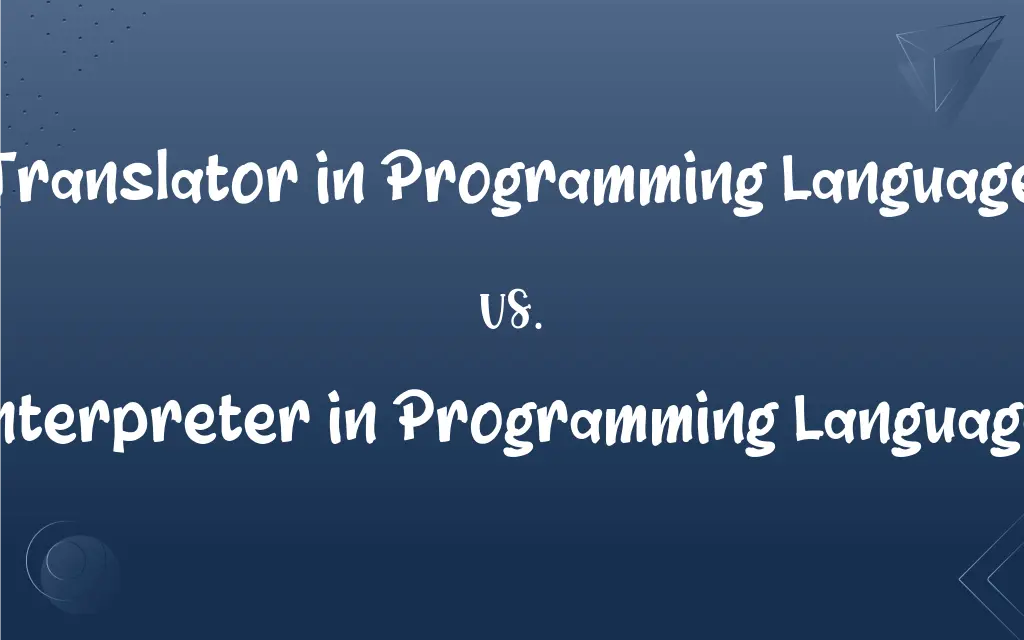Translator in Programming Language vs. Interpreter in Programming Language: What's the Difference?
Edited by Aimie Carlson || By Janet White || Published on March 4, 2024
A translator in programming converts code from one language to another, typically to machine code, while an interpreter executes code line-by-line without producing a separate executable.

Key Differences
In the context of programming languages, a translator is a tool that converts high-level code into another form, usually machine code or an intermediate form, enabling the computer to execute the instructions. This process can involve compilation, where the entire code is translated at once and saved as an executable file. An interpreter, on the other hand, directly executes the instructions written in a programming language without converting them into machine language first. It reads the code line by line, interprets it, and performs the specified actions immediately.
Translators are essential for languages like C and Java (to bytecode), where the source code must be transformed into a lower-level language that the computer can understand. This translation process happens before the program runs, which means that any errors in the code must be fixed beforehand. Interpreters are used with languages like Python and JavaScript, offering the advantage of immediate execution, which can be particularly useful for scripting, testing, and rapid prototyping.
The translation process performed by a translator is usually more time-consuming upfront because it involves analyzing and converting the entire codebase before execution. However, this leads to faster execution times later, as the translated program can be run directly by the machine. In contrast, interpreters can start executing the code almost immediately but may result in slower overall execution times since each line is interpreted on the fly during runtime.
One of the main advantages of using a translator is the optimization opportunities it presents. Since the entire code is visible during the translation process, compilers (a type of translator) can optimize the code to improve performance and efficiency. Interpreters, focusing on line-by-line execution, may not optimize the code as effectively, which can impact performance, especially in complex or long-running programs.
Translators and interpreters serve different purposes in the programming world, with the choice between them depending on the specific requirements of the project, such as execution speed, development time, and the programming languages used. While translators offer speed and efficiency, interpreters provide flexibility and ease of debugging, making them both invaluable tools in software development.
ADVERTISEMENT
Comparison Chart
Process
Converts entire code into machine code or intermediate code before execution.
Executes code line by line, interpreting each command on the fly.
Execution Time
Translation time is upfront, but execution is faster.
No upfront translation, but execution may be slower due to on-the-fly interpretation.
Use Case
Ideal for languages that require compilation, like C or Java.
Suitable for scripting and languages that prioritize rapid development, like Python.
Optimization
Can optimize code during translation, leading to more efficient execution.
Limited optimization opportunities due to line-by-line execution.
Error Handling
Errors must be fixed before execution after translation.
Errors are encountered and can be fixed during execution, allowing for immediate feedback.
ADVERTISEMENT
Translator in Programming Language and Interpreter in Programming Language Definitions
Translator in Programming Language
Performs syntax and semantic analysis to convert code.
The translator caught a syntax error in my code during the compilation process.
Interpreter in Programming Language
Ideal for scripting and rapid prototyping.
The interpreter allowed me to experiment with my code in real-time.
Translator in Programming Language
Facilitates the creation of stand-alone applications.
After the translator processed my code, I had a fully functional app.
Interpreter in Programming Language
Executes code directly, line by line.
I used an interpreter to quickly test my Python script.
Translator in Programming Language
Generates intermediate or machine-level code from source code.
My Fortran code became machine instructions thanks to the translator.
Interpreter in Programming Language
Facilitates interactive programming and debugging.
Debugging is easier with an interpreter, as it stops at errors immediately.
Translator in Programming Language
Converts high-level code to machine code.
The C compiler, acting as a translator, turned my source code into an executable.
Interpreter in Programming Language
Enables dynamic execution, useful for educational purposes.
Using an interpreter, students can see the immediate effects of their code changes.
Translator in Programming Language
Bridges the gap between human-readable code and machine-executable instructions.
Using a translator ensures my Java code runs efficiently on any machine.
Interpreter in Programming Language
Provides immediate execution without the need for compilation.
With the JavaScript interpreter, I can run code directly in my web browser.
FAQs
What does an interpreter do in programming?
An interpreter executes programming code line by line, translating it on the fly into machine-readable instructions.
What are the advantages of using a translator in programming?
Translators optimize code for efficiency and speed, making the final program run faster.
What is a translator in programming?
A translator converts high-level programming code into machine code or an intermediate form before execution.
What role does optimization play in translation versus interpretation?
Optimization is a key feature of translation, where code can be refined for performance, whereas interpretation offers limited optimization opportunities.
Can a programming language use both a translator and an interpreter?
Yes, some languages like Java use both, where the code is compiled into bytecode (translation) and then executed by a virtual machine (interpretation).
How does a translator differ from an interpreter in terms of execution speed?
A translator generally leads to faster execution since the code is pre-compiled, while an interpreter may be slower due to real-time interpretation.
Can an interpreter also perform compilation tasks?
Some interpreters compile code to an intermediate form before execution, but they don't produce standalone executable files like traditional compilers.
Why might a programmer prefer an interpreter over a translator?
Interpreters offer immediate feedback and are ideal for development environments that prioritize speed and flexibility over execution efficiency.
How does a translator impact the portability of software?
Software compiled by a translator may be less portable unless it's compiled for multiple platforms, while interpreted code is more portable but requires the interpreter on each platform.
How do errors get handled differently by translators and interpreters?
Translators identify errors during the compilation process, while interpreters encounter errors during execution, providing immediate feedback.
Are scripting languages typically interpreted or compiled?
Scripting languages, like Python and JavaScript, are typically interpreted to allow for quick execution and flexibility.
What is bytecode in the context of programming languages?
Bytecode is an intermediate code generated by a translator, which can then be executed by an interpreter, combining aspects of both translation and interpretation.
How does a JIT (Just-In-Time) compiler fit into the translator-interpreter dichotomy?
A JIT compiler, part of some interpreters, compiles bytecode to machine code on the fly, blending interpretation with compilation for improved performance.
How do translators handle different programming paradigms?
Translators can be designed to support various programming paradigms, including procedural, object-oriented, and functional programming, by translating high-level constructs into machine-appropriate code.
What is the significance of dynamic typing in interpreted languages?
Dynamic typing allows variables to be bound to objects of different types at runtime, which is a feature well-supported by interpreted languages due to their flexible nature.
How do memory management strategies differ between translated and interpreted languages?
Translated languages often provide more explicit control over memory management, while interpreted languages tend to automate memory management, trading off some efficiency for convenience.
Do translators and interpreters affect the choice of programming language for a project?
Yes, the choice between using a translated or interpreted language can depend on project requirements, such as execution speed, development efficiency, and platform compatibility.
What is an interactive interpreter, and how does it benefit programmers?
An interactive interpreter allows programmers to execute code line by line interactively, which is beneficial for learning, debugging, and exploratory programming.
What impact do translators and interpreters have on software development cycles?
Translators may lead to longer development cycles due to the compile-time, while interpreters can shorten the cycle with immediate execution and debugging.
How do cloud computing and virtualization affect the use of translators and interpreters?
Cloud environments often use both translators and interpreters, offering flexibility and scalability by compiling code for optimal performance and interpreting code for dynamic, distributed execution.
About Author
Written by
Janet WhiteJanet White has been an esteemed writer and blogger for Difference Wiki. Holding a Master's degree in Science and Medical Journalism from the prestigious Boston University, she has consistently demonstrated her expertise and passion for her field. When she's not immersed in her work, Janet relishes her time exercising, delving into a good book, and cherishing moments with friends and family.
Edited by
Aimie CarlsonAimie Carlson, holding a master's degree in English literature, is a fervent English language enthusiast. She lends her writing talents to Difference Wiki, a prominent website that specializes in comparisons, offering readers insightful analyses that both captivate and inform.







































































